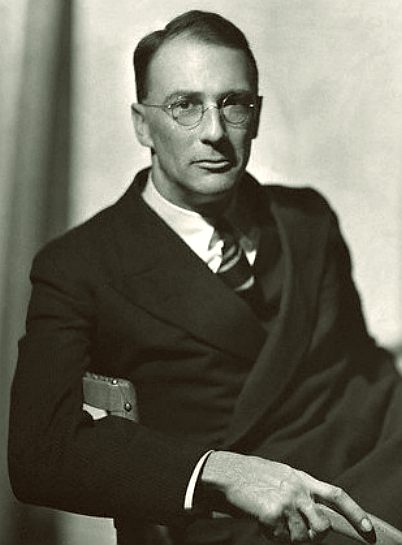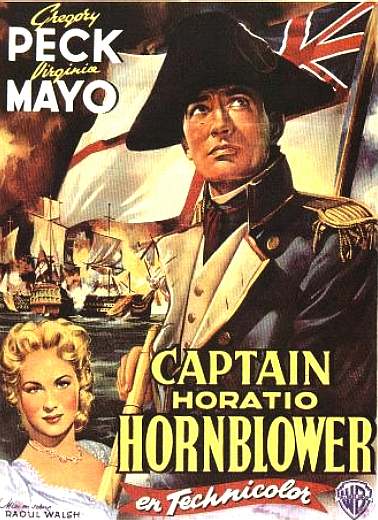|
Cecil Scott "C. S." Forester was the pen name of Cecil Louis Troughton Smith (27 August 1899 — 2 April 1966), an English novelist who rose to fame with tales of naval warfare. His most notable works were the 12-book Horatio Hornblower series, depicting a
Royal Navy officer during the Napoleonic era, and The African Queen (1935; filmed in 1951 by John Huston). His novels A Ship of the Line and Flying Colours were jointly awarded the 1938 James Tait Black Memorial Prize for fiction.

HISTORY
Forester was born in Cairo and, after a family breakup at an early age, he moved with his mother to London and was educated at Alleyn's School, Dulwich College, south London, and Guy's Hospital, London, but did not complete his studies at the last named. "Forester had always worn glasses and been thin. Later, trying to enlist in the army he failed his physical and was told there was not a chance that we would be accepted even though he was of good height and somewhat athletic. In about 1921, after studying medicine for several years, he left academia and began writing seriously using his pen name."
MARRIAGE
He married Kathleen Belcher in 1926, had two sons (John and George Forester) and divorced in 1945. His elder son, John Forester, wrote a biography of his father.
WORLD WAR II
During World War II, Forester moved to the United States where he worked for the British Information Service and wrote propaganda to encourage the US to join the Allies. He eventually settled in Berkeley, California. While living in Washington, D.C., he met a young British intelligence officer named Roald Dahl, whose experiences in the RAF he had heard of, and encouraged him to write about them. In 1947, he secretly married a woman named Dorothy Foster.
WRITING CAREER
Forester wrote many other novels, among them The African Queen (1935) and The General (1936); Peninsular War novels in Death to the French (published in the United States as Rifleman Dodd) and The Gun (filmed as The Pride and the Passion in 1957); and seafaring stories that did not involve Hornblower, such as Brown on Resolution (1929); The Captain from Connecticut (1941); The Ship (1943) and Hunting the Bismarck (1959), which was used as the basis of the screenplay for the 1960 film Sink the Bismarck! Several of his works were filmed, most notably the 1951 film The African Queen, directed by John Huston. Forester is also credited as story writer for several movies not based on his published fiction, including Commandos Strike at Dawn (1942).
He wrote several volumes of short stories set during the Second World War. Those in The Nightmare (1954) were based on events in Nazi Germany, ending at the Nuremberg Trials. Stories in The Man in the Yellow Raft (1969) followed the career of the destroyer USS Boon, while many of those in Gold from Crete (1971) followed the destroyer HMS Apache. The last of the stories in the latter book - "If Hitler had invaded England" - offers an imagined sequence of events starting with Hitler's attempt to implement Operation Sea Lion, and culminating in the early military defeat of
Nazi Germany in the summer of 1941. His non-fiction seafaring works include The Age of Fighting Sail (1956), an account of the sea battles between Great Britain and the United States in the War of 1812.
In addition to his novels of seafaring life, Forester also published two crime novels, Payment Deferred (1926), and Plain Murder (1930), and two children's books. One, Poo-Poo and the Dragons (1942), was created as a series of stories told to his younger son George to encourage him to finish his meals. George had mild food allergies that kept him feeling unwell, and he needed encouragement to eat. The second, The Barbary Pirates (1953), is a children's history of those early 19th-century pirates.
He can be seen as a contestant on 1 November 1956 edition of You Bet Your Life, commenting that his latest book is The Age of Fighting Sail.
In 2003 a "lost" novel of Forester's, The Pursued, was discovered and bought at an auction and was published by Penguin Classics on 3 November 2011.
British author Roald Dahl's writing career began after he met Forester in early 1942. According to Dahl's autobiographical Lucky Break, Forester asked Dahl about his experiences as a fighter pilot. This prompted Dahl to write his first story, "A Piece of Cake".
HORNBLOWER
MOVIE
1951
Captain Horatio Hornblower R.N. (released in the U.S. without the 'R.N.') is a 1951 naval adventure film. It was directed by Raoul Walsh and stars Gregory Peck, Virginia Mayo, Robert Beatty and Terence Morgan.
The film has become a classic, to be ranked with others such as Mutiny
on the Bounty starring Marlon Brando, rather than the Mel Gibson
remake with Anthony Hopkins..
The 1951 movie was based upon three of C. S. Forester's Horatio Hornblower novels, The Happy Return (Beat to Quarters in the United States), A Ship of the Line and Flying Colours. Forester is credited with the adaptation; as a result, the film is faithful to his novels and features an occasionally introspective tone unusual for an old-fashioned swashbuckler.
PLOT
In 1807, during the Napoleonic Wars, English Royal Navy Captain Horatio Hornblower (Gregory Peck) commands the 38-gun frigate HMS Lydia on a lengthy secret mission to Central America. He is to provide arms and support to a megalomaniac named Don Julian Alvarado, who is calling himself "El Supremo" or "The Almighty" (Alec Mango), in his rebellion against Spain, an ally of Britain's enemy France. As Hornblower observes to First Lieutenant Bush (Robert Beatty), "War breeds strange allies."
Upon his arrival, Hornblower is told that a larger, much more powerful Spanish
warship, the 60-gun Natividad, has been sighted. When it anchors nearby, Hornblower and his crew board and capture it in a surprise nighttime attack. He then reluctantly hands the ship over to Alvarado to appease the madman, and they go their separate ways.
Later, he encounters a small Spanish vessel and learns that Spain has switched sides, so the Lydia will have to attack the Natividad again. Two passengers transfer to the Lydia (over Hornblower's objections): Lady Barbara Wellesley (Virginia Mayo) and her maid, fleeing a yellow fever epidemic. As Lady Barbara is the (fictitious) sister of the Duke of Wellington (an anachronism, as the title was created in 1814 and he would have been Sir Arthur Wellesley at this time), Hornblower is in no position to refuse her request for passage to England.
Using superior seamanship and masterful tactics, Hornblower sinks the Natividad, and when the ship's surgeon is killed in the battle, Lady Barbara insists on helping by nursing the wounded. When she later falls gravely ill, Hornblower nurses her back to health. On the voyage back to England, they fall in love. However, when she makes advances (although she is engaged), Hornblower informs her he is married.

Indefatigable takes on a 40 gun French frigate
After arriving home, Hornblower learns that his wife has died in childbirth, leaving him an infant son. He is given command of the Sutherland, a 74-gun ship of the line captured from the French, and is assigned to a squadron commanded by Rear Admiral Leighton (Denis O'Dea), Lady Barbara's new husband. The squadron's mission is to help enforce the British blockade against Napoleonic France.
At a conference on Leighton's flagship, Hornblower learns that four French ships of the line have broken the blockade. Leighton assumes they will make for the Mediterranean, but Hornblower suggests that they mean to support
Napoleon's campaign on the Iberian Peninsula.
Leighton decides to cover both possibilities by detaching one ship to patrol the French coast. When he learns that Hornblower's Sutherland is best suited for this task, having the shallowest draught, he becomes suspicious that Hornblower is after glory and prize money. Leighton therefore expressly forbids Hornblower from taking any independent action if he sights the French.
Hornblower's French-built ship is subsequently mistaken for a friendly vessel by a small French brig, which flies the enemy's recognition signal for the day. After capturing the vessel, Hornblower learns from interrogating its captain that he was transporting army supplies to the four warships for use in Spain. Rather than return to the squadron, Hornblower sends the brig back with a prize crew and the news.
He enters the enemy harbour where the French ships are anchored and guarded by a well-armed fort. By flying a French flag and the recognition signal and taking advantage of the appearance of his ship's French design, Hornblower fools the garrison into believing that the Sutherland is friendly. His gun crews dismast all four enemy ships before French cannon fire forces the British to abandon the Sutherland. Hornblower scuttles his ship in the channel, bottling up the French ships.
As the rest of the British squadron arrives to complete the job, Hornblower and Bush, accompanied by seaman Quist (James Robertson Justice), are taken by carriage to Paris to be tried for piracy. However, they manage to escape en route and make their way to the port of Nantes. Disguised as Dutch officers, they board The Witch of Endor, a captured British ship. They overpower the skeleton crew, free a working party of British prisoners of war to man her, and sail away to freedom.
Hornblower is hailed as a national hero, and learns that Leighton was killed in the battle. Hornblower returns home to visit his young son, and finds Lady Barbara there. The two embrace.

PRODUCTION
The film was shot at studios inside the United
Kingdom, on Mermaid Street in Rye, East Sussex, at HMS Victory and also on location in France. To save costs, the Hispaniola set from the 1950 Disney film adaptation of Treasure Island was reused as the frigate HMS Lydia. However, the ship was rocked instead of moving the horizon background, which caused many problems because of the combined weight of ship crew and equipment. The Italian brigantine Marcel B. Surdo represented the The Witch of Endor for all at-sea exterior footage. The Marcel B. Surdo would also appear in such seafaring films as The Crimson
Pirate, The Master of Ballantrae, and John Paul Jones. The explosive and fire effects were supervised by Cliff Richardson.
RELEASE
The film made its worldwide premiere in New York on September 13, 1951. It was the 9th most popular film at the British box office that year.
MODERN REVIEW
The film has been well received by modern critics with film aggregate site Rotten Tomatoes giving it 7.3 out of 10 and a 100% 'fresh'
rating.
The film is shown regularly on network television,
especially at Christmas.
LINKS
http://en.wikipedia.org/wiki/C._S._Forester
NOVELIST
INDEX
A - Z

A
heartwarming adventure: pirate
whalers V conservationists
|


